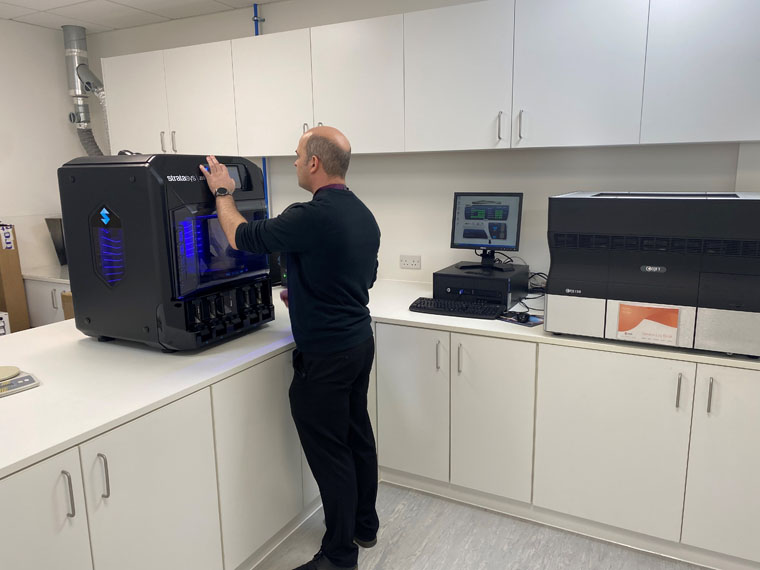Sepura, a UK-based provider of telecommunications equipment, has begun using Stratasys’ PolyJet 3D printing technology in its day-to-day operations.
Leveraging a recently-purchased Stratasys J35 Pro system, the company claims it’s been able to improve both the design and lead times of its new products. Specifically, Sepura is now able to create much more sophisticated prototypes, at lower costs, all while slashing lead times from up to two weeks to just one day.
“We are often asked to design bespoke solutions to match a particular user need and to develop these in co-operation with customers,” says Robert Wright, Principal Mechanical Design Engineer at Sepura. “We were already familiar with the benefits of 3D printing having used Stratasys’ PolyJet technology in the past.”

Sepura’s new take on rapid prototyping
Based in the city of Cambridge, Sepura specializes in the design and manufacture of mobile radio devices for applications such as public safety, as well as for commercial enterprises. The firm’s own communications technology is the backbone of many rapid response organizations, including police forces, fire services, ambulance services, and public transport.
Owing to the high-stakes nature of its customers’ work, Sepura’s product prototypes must be true-to-life. It’s crucial for the firm to be able to quickly and easily validate their prototypes for dimensional fit and reliability before deploying the designs out in the field.
Since installing the J35 Pro, Sepura has utilized the system to rapidly prototype test models for its upcoming radios and functional test pieces for battery development purposes. Additionally, the machine has allowed for faster design iterations and shorter development cycles.
Wright adds, “The J35 Pro adds another important layer to our existing 3D printing capabilities – not only can we now cost-effectively create true-to-life prototype models in-house, but we have also cut our production time by 90%, which is more than we could have ever imagined.”

The Stratasys J35 Pro
The J35 Pro is known for being Stratasys’ first multi-material 3D printer built for the desktop. Characterized by its distinctly compact frame, the system can combine up to three different polymer materials per build, enabling everything from high-fidelity decorative pieces to functional engineering prototypes. The machine also lends itself to hands-free soluble supports, streamlining the post-processing workflow.
Designed to be used in the office, the J35 Pro is both silent and odor-free. It also requires minimal maintenance due to its use of a rotating build tray, meaning there aren’t all that many moving parts within.
“The variety of materials available with the J35 Pro allows us to create accurate prototypes and means our customers receive a detailed tangible model they can hold in their hands, move and test,” said Paul Tindall, Head of R&D at Sepura. “We have found Elastico™ material to be particularly beneficial – we are able to produce sealing prototypes that simulate the look, feel and function of rubber and can withstand repeated flexing and bending.”

The applications of Stratasys’ technologies stretch far and wide. Earlier this year, the company made it onto a new Discovery+ documentary, Radford Returns, when it designed and 3D printed more than 500 parts for a relaunch of the classic Lotus Type 62-2 sports car. The team used the F900, F770, Fortus 450mc, F370 and J55 3D printers to produce different desired outcomes for a variety of parts, including large composite firewall sandwich cores and smaller exterior items like side mirror housings.
Elsewhere, Stratasys recently partnered with digital services firm Ricoh USA to provide point-of-care 3D printed anatomic modeling services to healthcare facilities. The partnership will see Stratasys’ 3D printing technology integrated into Ricoh USA’s Ricoh 3D for Healthcare workflow in order to increase access to 3D printed medical models for medical facilities and clinicians.
Subscribe to the 3D Printing Industry newsletter for the latest news in additive manufacturing. You can also stay connected by following us on Twitter, liking us on Facebook, and tuning into the 3D Printing Industry YouTube Channel.
Looking for a career in additive manufacturing? Visit 3D Printing Jobs for a selection of roles in the industry.
Featured image shows a 3D printed prototype for a radio product. Photo via Stratasys.


